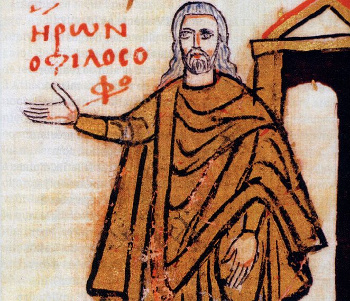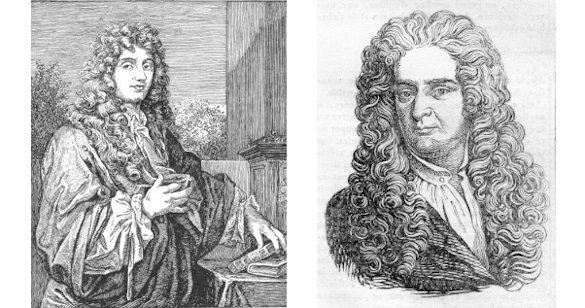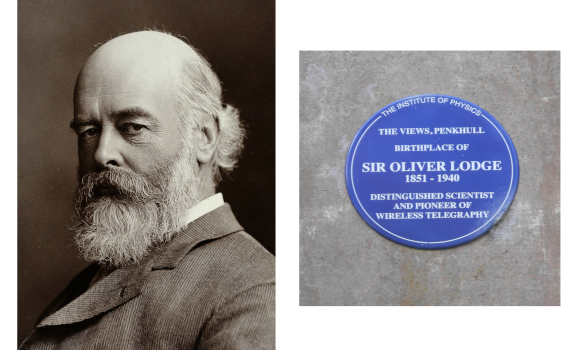Speed of Light
April 3, 2023
The
speed of light in
vacuum, symbolized by
c, has an exact value of 299,792,458
meters/second. The reason for the exactness of this value is that in 1983 it became a fixed quantity used to define the
meter, rather than the other way around. The meter was previous defined in reference to a
physical object kept at the
International Bureau of Weights and Measures near
Paris. To obtain the meter from the speed of light, you also need a
definition for a
second. This is defined as the duration of 9,192,631,770
periods of the
radiation from a certain electron transition in
cesium-133.
Why is the speed of light in a vacuum
symbolized as
c? The acclaimed
science and
science fiction author,
Isaac Asimov (1920-1992),
stated the false
idea that this relates to the initial
letter of the
Latin word, "celeritas," meaning
speed. In actuality, it's derived from the use of the letter to symbolize a
constant. This can be traced back to 1856 in a
paper by
German physicists,
Wilhelm Weber (1804-1891) and
Rudolf Kohlrausch (1809-1858) in which
c is used as a constant in a
force equation. Before that time, the use of the
character v was common, and this
convention was used by
James Clerk Maxwell (1831-1879) in his 1865 paper,
A Dynamical Theory of the Electromagnetic Field,[1] and by
Albert Einstein (1879-1955) in his first papers on
relativity.
Most physicists use 300,000,000 meters/sec for the speed of light in casual
calculation, since it's easy to
remember, and it's just 0.07% larger than the actual value. The speed of light is so large that it appears to be
infinite.
Aristotle (384-322 BC) thought light traveled at infinite speeds. An earlier
Greek philosopher,
Empedocles (c.494-c.434 BC), originated the
emission theory of sight in which light is emitted by the
eyes and was
reflected back to the
observer to enable
sight.
While Empedocles believed that the speed of light was finite,
Hero of Alexandria (fl. 60 AD) reasoned by the emission theory that the speed of light must be infinite, since we instantly see distant objects, such as
stars, when we open our eyes. The emission theory was embraced by
Euclid (fl. 300 BC) and
Ptolemy (c.100-c.170 AD). As to the actual
nature of light,
Democritus (c.460-c.370 BC) was quite near to the
truth when he wrote that light consisted of small invisible
particles moving at a finite speed. Contrary to the emission theory, these
photons are emitted from the source. Aristotle thought that light was not a
substance, but rather a
state of transparency.

Hero of Alexandria, from the Codex of Saint Gregory Nazianzenos, a Greek manuscript of the 9th century.
Hero is known for many things, including Hero's formula giving the area of a triangle from its sides.
As I wrote in an earlier article (Steam Power, January 28, 2011), Hero (more properly, Heron) demonstrated a steam engine, called an Aeolipile, in the 1st century AD.
(Wikimedia Commons image.)
The first
experiment designed to measure the speed of light was performed by
Galileo in 1638. The experiment was done using
signal lanterns separated by a large distance, and he concluded that the speed was either very rapid or instantaneous. The round-trip transit time of light over a
mile's distance is just 10.73
microseconds, which is too short an interval for
humans to notice.
A half
century after Galileo's experiment,
Christiaan Huygens (1629-1695) published his 1690
Traité de la Lumière (Treatise on Light). In this
book, Huygens presented a
wave theory of light. According to Huygens, light is a stream of
spherical waves emitted from a luminous source. The
vibrations are
along the direction of light travel. These waves propagate in the now infamous
luminiferous ether that permeates the
universe.
Huygen's
contemporary,
Isaac Newton (1642-1727), had a different theory of light. Newton believed that light was composed of
particles that he named
corpuscles; and, as particles, they were influenced by
inertia and
gravity. One
proof of this theory was that light
reflects off
plane surfaces just as a
ball would. Our present idea of light is that
it sometimes behaves as a wave, and it sometimes behaves as a particle.

Left, Christiaan Huygens (1629-1695). Right, Isaac Newton (1642-1727). (Left image, a Wikimedia Commons image from the 1920 book, "Practical Physics," by Millikan and Gale. Right image via Wikimedia Commons
The
Danish astronomer,
Ole Rømer, was the first to give an actual value for the speed of light. In 1676, Rømer used the
period of
Jupiter's moon,
Io, as a
clock to find a value of 220,000,000 meters/sec, which is about 75% of the established value. His measurement was based on the idea that light needed to travel farther when
Earth was on the opposite side of the
Sun from Jupiter, but the
orbits of Earth and Jupiter were not that well known in his time, leading to his rather large
error. A more
accurate astronomical measurement was made in 1729 by
English astronomer,
James Bradley, who used his discovery of the
aberration of light to
calculate its speed to within 1.5% of its established value.
While the speed of light appears to be constant, might its value have been different in the
early universe? The
fine structure constant, a
dimensionless number calculated from the speed of light and other
fundamental constants, is important to the stability of
atoms. Observation has shown that its rate of change, if it does change at all, is extremely small, of the order of (-1.6±2.3)x10
-17 parts per year.[2] Another astronomical measurement of 120 ultra-compact
radio sources gave an estimate of the speed of light when the universe was just 3.80 billion years old. That estimate, 2.995(±0.235)x10
5 km/s, is consistent with our accepted value of 299,792,458 meters/second.[3]
A recent paper in
arXiv by
scientists at the
Laboratoire National des Champs Magnétiques Intenses (Toulouse, France) examines the
history of experiments on the possible affect of
magnetic fields on the speed of light.[4] As they write early in their paper, its title, "On the speed of light in a vacuum in the presence of a magnetic field," would have been considered as
nonsense just a few centuries ago... "Not only because we talk about light velocity but also because we assume the existence of a
vacuum, a thing that has been considered impossible for centuries following the Aristotle teaching."[4]
That light is affected at all by a magnetic field was established by
Michael Faraday (1791-1867) in 1845 when he observed what is now called the
Faraday effect in which the
linear polarization of light
rotates in the presence of a magnetic field along its propagation direction in certain
materials. This effect is present in many
aluminum garnets, a fact that enabled one of my early
inventions.[5] Since
intense electric fields were more easily obtained in the
19th century, the initial efforts were on determining whether the speed of light is influenced by an electric field. As H. Wild wrote (in
German) in 1865,
"Since November 1860, I performed some experiences to test experimentally the consequences of this hypothesis. Since all of them has given a negative result, and that for some of them I have employed somewhat inadequate apparatus, I had avoided to publish them. Since then, discussion with some physicists, friends of mine, have shown me that others have also tested experimentally this hypothesis with as few success as me. I have thought then that it was worth while to report to the public my investigations on this point, that I have been somewhat finishing this autumn, even if it has done nothing more than confirming my previous negative results."[6]

Sir Oliver Lodge (1851-1940) with historical plaque marking his birthplace. Lodge, who became a Doctor of Science in 1877, was awarded the Rumford Medal of the Royal Society in 1898, and he was knighted in 1902. He was a staunch advocate of Maxwell's theory of the luminiferous aether, defending it into the 20th century. He is known for his radio research, and he was able to sell one of his patents to the Marconi Company in 1912. (Left, a Wikimedia Commons portrait of Lodge from the Wellcome Collection, image reference 13104i. Right, a Wikimedia Commons image by Rept0n1x. Click for larger image.)
Radio pioneer,
Oliver Lodge (1851-1940) examined the affect of electric and magnetic fields on light in 1897. As he wrote, "without further delay I conclude that neither an electric nor a magnetic transverse field confers
viscosity upon the ether, nor enables moving
matter to grip and move it rotationally."[7] In most of Lodge's life, light propagation was assumed to be through the ether, and thus his wording. However, the famous
Michelson and Morley experiment disproving the ether was published ten years earlier, in 1887; thereby, proving again, that
old habits die hard.
Albert Einstein (1879-1955) is quoted in the arXiv paper as saying, "I think that
die liebe Gott could not have created the world in such a fashion that a magnetic field would be unable to influence the velocity of light.[4] As we now know, the
vacuum state is not really devoid of substance. It's a
quantum foam in which
virtual particles enter into a brief
existence, then
vanish.
Quantum electrodynamics gives a
prediction for the influence of a magnetic field on the speed of light. It changes about a few parts in 10
24 in a one
tesla applied field.[4]
Laboratory magnets can produced about 10 teslas of magnetic field; so, the change would be 10
-23, not within the realm of experimental proof.
References:
- J. Clerk Maxwell, "A Dynamical Theory of the Electromagnetic Field," Philosophical Transactions of the Royal Society of London, vol. 155 (December 31, 1865), pp. 459-512. doi:10.1098/rstl.1865.0008. See, for example, p. 492.
- T. Rosenband, D. B. Hume, P. O. Schmidt†, C. W. Chou, A. Brusch, L. Lorini, W. H. Oskay, R. E. Drullinger, T. M. Fortier, J. E. Stalnaker, S. A. Diddams, W. C. Swann, N. R. Newbury, W. M. Itano, D. J. Wineland, and J. C. Bergquist, "Frequency Ratio of Al+ and Hg+ Single-Ion Optical Clocks; Metrology at the 17th Decimal Place," Science, vol. 319, no.5871 (March 28, 2008), pp. 1808-1812, DOI: 10.1126/science.1154622.
- Shuo Cao, Marek Biesiada, John Jackson, Xiaogang Zheng, and Zong-Hong Zhu, "Measuring the speed of light with ultra-compact radio quasars," arXiv, September 28, 2016.
- Jonathan Agil, Rémy Battesti, and Carlo Rizzo, "On the speed of light in a vacuum in the presence of a magnetic field," arXiv, February 6, 2023, https://doi.org/10.48550/arXiv.2302.00661.
- Devlin M. Gualtieri, "Magneto-Optical Waveguides of Aluminum Garnet," U.S. Pat. No. 5,245,689 (Sept. 14, 1993).
- H. Wild,"Untersuchungen über die Identität von Lichtäther und elektrischem Fluidum," Annalen der Physik, vol. 200, no. 3 (1965), pp. 507-512.
- O. J. Lodge, "Experiments on the Absence of Mechanical Connexion between Ether and Matter," Philosophical Transactions of the Royal Society of London. Series A, vol. 189, pp. 149–166, https://doi.org/https://doi.org/10.1098/rsta.1897.0006.
Linked Keywords: Speed of light; vacuum; meters per second; meters/second; meter; international prototype meter; physical object; International Bureau of Weights and Measures; Paris; definition; second; frequency; period; cesium standard; electron transition; cesium-133; symbol; symbolize; science; science fiction; author; Isaac Asimov (1920-1992); publication; stated; idea; letter (alphabet); Latin word; speed; constant (mathematics); scientific literature; paper; Germany; German; physicist; Wilhelm Weber (1804-1891); Rudolf Kohlrausch (1809-1858); force; equation; alphabet; character; convention (norm); James Clerk Maxwell (1831-1879); A Dynamical Theory of the Electromagnetic Field; Albert Einstein (1879-1955); theory of relativity; calculation; long-term memory; remember; infinite; Aristotle (384-322 BC); Greek philosopher; Empedocles (c.494-c.434 BC); eye beam; emission theory of sight; eye; reflection (physics); observer; visual perception; sight; Hero of Alexandria (fl. 60 AD); star; Euclid (fl. 300 BC); Ptolemy (c.100-c.170 AD); teleology; nature; Democritus (c.460-c.370 BC); truth; elementary particle; photon; substance; transparency and translucency; state of transparency; Codex; Saint Gregory Nazianzenos; Greek language; manuscript; 9th century; Hero's formula; steam engine; Aeolipile<; 1st century AD; Wikimedia Commons; experiment; Galileo Galilei; signal lantern; mile; microsecond; human; century; Christiaan Huygens (1629-1695); publication; published; Traité de la Lumière (Treatise on Light); book; wave theory of light; wave equation; spherical wave; emissivity; emitted; vibration; Poynting vector; direction of light travel; luminiferous ether; universe; contemporary; Isaac Newton (1642-1727); particle; inertia; gravitation; gravity; proof of concept; reflect; plane (geometry); plane surface; ball; wave-particle duality; sometimes behaves as a wave, sometimes behaves as a particle; Denmark; Danish; astronomer; Ole Rømer; periodic function; period; Jupiter; natural satellite; moon; Io (moon); clock; Earth; Sun; orbit; measurement uncertainty; error; accuracy and precision; accurate; astronomy; astronomical; English; James Bradley; aberration of light; calculation; calculate; age of the universe; early universe; fine structure constant; dimensionless number; physical constant; fundamental constant; atoms; parts-per notation; parts per year; astronomical radio source; arXiv; scientist; Laboratoire National des Champs Magnétiques Intenses (Toulouse, France); history; magnetic field; nonsense; vacuum; Michael Faraday (1791-1867); Faraday effect; polarization (waves); linear polarization; rotation; rotate; material; aluminum; garnet; invention; intensity (physics); intense; electric fields; 19th century; German language; hypothesis; null result; negative result; scientific instrument; apparatus; autumn; Sir Oliver Lodge (1851-1940); commemorative plaque; birthplace; Doctor of Science; Rumford Medal; Royal Society; knight; advocate; 20th century; radio wave; patent; Marconi Company; Rept0n1x; viscosity; matter; Michelson and Morley experiment; old habits die hard; vacuum state; quantum foam<; virtual particle; existence; vanish; quantum electrodynamics; prediction in science; tesla (unit); laboratory; electromagnet; magnet.